Voltage Control Methodologies in Active Distribution Networks
Abstract
1. Introduction
2. Distribution Management Systems
Smart DSO SCADA System Architecture
- Planned Work Management to coordinate and support planned field network activities;
- Outage Management, to react to unplanned outages in the network and minimize the outage time and number of unsupplied customers.
- Load and Generation Forecast System;
- Network Calculation Algorithm System (NCAS): Network Estimation and control algorithms (Voltage Regulation, Optimal Power Flow, Emergency Restoration, etc.).
3. Voltage Control Approaches
3.1. Local Control Strategy
3.2. Coordinated Control Strategy
3.3. Centralized Control Strategy
3.3.1. Objective Function
3.3.2. Constraints
3.3.3. Modeling the OLTC Transformer
4. Results and Discussion
4.1. Case Study Description
4.2. Local vs. Coordinated Control
4.3. Centralized Control
4.4. Results Review and Discussion
5. Conclusions
Author Contributions
Funding
Conflicts of Interest
Abbreviations
| CVC | Coordinated Voltage Control |
| DG | Distributed Generators |
| DN | Distribution Network |
| DSO | Distribution System Operator |
| GA | Genetic Algorithm |
| GPRS | General Packet Radio Service |
| HC | Hosting Capacity |
| HV | High Voltage |
| LV | Low Voltage |
| MINLP | Mixed-Integer Non-Linear Programing |
| MV | Medium Voltage |
| NCAS | Network Calculation Algorithm System |
| NLP | Non-Linear Programing |
| OLTC | On-Load Tap Changer |
| OP | Optimization Problem |
| ORPF | Optimal Reactive Power Flow |
| PCC | Point of Common Coupling |
| PLC | Power-Line Communication |
| PF | Power Flow |
| PSO | Particle Swarm Optimization |
| RES | Renewable Energy Sources |
| SCADA | Supervisory Control And Data Acquisition |
| STATCOM | STATic COMpensator |
| SVC | Static Var Compensator |
| TSO | Transmission System Operator |
References
- Lopes, J.P.; Hatziargyriou, N.; Mutale, J.; Djapic, P.; Jenkins, N. Integrating distributed generation into electric power systems: A review of drivers, challenges and opportunities. Electr. Power Syst. Res. 2007, 77, 1189–1203. [Google Scholar] [CrossRef]
- Directive (EU) 2018/2001 of the European Parliament and of the Council of 11 December 2018 on the Promotion of the Use of Energy from Renewable Sources. Available online: https://eur-lex.europa.eu/ (accessed on 23 April 2020).
- Gallanti, M.; Merlo, M.; Moneta, D.; Mora, P.; Monfredini, G.; Olivieri, V. MV network with Dispersed Generation: Voltage regulation based on local controllers. In Proceedings of the 21th International Conference on electricity Distribution CIRED, Frankfurt, Germany, 6–9 June 2011. [Google Scholar]
- Arrigoni, C.; Bigolini, M.; Bovo, C.; Ilea, V.; Merlo, M.; Monfredini, G.; Subasic, M.; Bonera, R. Smart distribution system the InGrid project and the evolution of supervision & control systems for Smart Distribution System management. In Proceedings of the 2013 AEIT Annual Conference: Innovation and Scientific and Technical Culture for Development, AEIT 2013, Mondello, Italy, 3–5 October 2013. [Google Scholar]
- Berizzi, A.; Bovo, C.; Falabretti, D.; Ilea, V.; Merlo, M.; Monfredini, G.; Subasic, M.; Bigoloni, M.; Rochira, I.; Bonera, R. Architecture and functionalities of a smart Distribution Management System. In Proceedings of the 16th International Conference on Harmonics and Quality of Power, ICHQP 2014, Bucharest, Romania, 25–28 May 2014. [Google Scholar]
- Arrigoni, C.; Bigoloni, M.; Rochira, I.; Bovo, C.; Merlo, M.; Ilea, V.; Bonera, R. Smart Distribution Management System: Evolution of MV grids supervision & control systems. In Proceedings of the 2016 AEIT International Annual Conference, AEIT 2016, Capri, Italy, 5–7 October 2016. [Google Scholar]
- Delfanti, M.; Fasciolo, E.; Olivieri, V.; Pozzi, M. A2A project: A practical implementation of smart grids in the urban area of Milan. Electr. Power Syst. Res. 2015, 120, 2–19. [Google Scholar] [CrossRef]
- Bosisio, A.; Berizzi, A.; Morotti, A.; Pegoiani, A.; Greco, B.; Iannarelli, G. IEC 61850-based smart automation system logic to improve reliability indices in distribution networks. In Proceedings of the 2019 AEIT International Annual Conference, AEIT 2019, Firenze, Italy, 18–20 September 2019. [Google Scholar]
- Coppo, M.; Pelacchi, P.; Pilo, F.; Pisano, G.; Soma, G.G.; Turri, R. The Italian smart grid pilot projects: Selection and assessment of the test beds for the regulation of smart electricity distribution. Electr. Power Syst. Res. 2015, 120, 136–149. [Google Scholar] [CrossRef]
- Bovo, C.; Ilea, V.; Subasic, M.; Rochira, I.; Arrigoni, C. Innovative methodology for observability improvement of distribution networks. In Proceedings of the 2015 IEEE Eindhoven PowerTech, PowerTech 2015, Eindhoven, The Netherlands, 29 June–2 July 2015. [Google Scholar]
- Bovo, C.; Ilea, V.; Subasic, M.; Zanellini, F.; Arigoni, C.; Bonera, R. Improvement of observability in poorly measured distribution networks. In Proceedings of the 2014 Power Systems Computation Conference, PSCC 2014, Wroclaw, Poland, 18–22 August 2014. [Google Scholar]
- Falabretti, D.; Delfanti, M.; Merlo, M. Distribution networks’ observability: A novel approach and its experimental test. Sustain. Energy Grids Netw. 2018, 13, 56–65. [Google Scholar] [CrossRef]
- Singh, R.; Pal, B.C.; Vinter, R.B. Measurement placement in distribution system state estimation. IEEE Trans. Power Syst. 2009, 24, 668–675. [Google Scholar] [CrossRef]
- Bovo, C.; Ilea, V.; Subasic, M. Optimization of Measurement Equipment Placement in Distribution Networks by Genetic Algorithms. In Proceedings of the 2018 IEEE International Conference on Environment and Electrical Engineering and 2018 IEEE Industrial and Commercial Power Systems Europe, EEEIC/I&CPS Europe 2018, Palermo, Italy, 12–15 June 2018. [Google Scholar]
- Yao, Y.; Liu, X.; Li, Z. Robust Measurement Placement for Distribution System State Estimation. IEEE Trans. Sustain. Energy 2019, 10, 364–374. [Google Scholar] [CrossRef]
- Mirbagheri, S.M.; Falabretti, D.; Merlo, M. Voltage Control in Active Distribution Grids: A Review and a New Set-Up Procedure for Local Control Laws. In Proceedings of the 2018 International Symposium on Power Electronics, Electrical Drives, Automation and Motion (SPEEDAM), Amalfi, Italy, 20–22 June 2018. [Google Scholar]
- Italian Electrical Committee (CEI). Reference Technical Rules for the Connection of Active and Passive Users to the LV Electrical Utilities, Technical Standard CEI 0-21, in Italian; CEI: Milan, Italy, 2012. [Google Scholar]
- Vovos, P.N.; Kiprakis, A.E.; Wallace, A.R.; Harrison, G.P. Centralized and distributed voltage control: Impact on distributed generation penetration. IEEE Trans. Power Syst. 2007, 22, 476–483. [Google Scholar] [CrossRef]
- Turitsyn, K.; Sulc, P.; Backhaus, S.; Chertkov, M. Local Control of Reactive Power by Distributed Photovoltaic Generators. In Proceedings of the 2010 First IEEE International Conference on Smart Grid Communications, Gaithersburg, MD, USA, 4–6 October 2010; pp. 79–84. [Google Scholar] [CrossRef]
- Elnashar, M.; Kazerani, M.; Shatshat, R.E.; Salama, M.M.A. Comparative evaluation of reactive power compensation methods for a stand-alone wind energy conversion system. In Proceedings of the 2008 IEEE Power Electronics Specialists Conference, Rhodes, Greece, 15–19 June 2008; pp. 4539–4544. [Google Scholar] [CrossRef]
- Aggarwal, M.; Gupta, S.K.; Madhusudan, M.; Kasal, G. DSTATCOM Control in Low Voltage Distribution System with Distributed Generation. In Proceedings of the 2010 3rd International Conference on Emerging Trends in Engineering and Technology, Goa, India, 19–21 November 2010; pp. 426–429. [Google Scholar] [CrossRef]
- Caples, D.; Boljevic, S.; Conlon, M.F. Impact of distributed generation on voltage profile in 38 kV distribution system. In Proceedings of the 2011 8th International Conference on the European Energy Market (EEM), Zagreb, Croatia, 25–27 May 2011; pp. 532–536. [Google Scholar] [CrossRef]
- Sansawatt, T.; Ochoa, L.F.; Harrison, G.P. Integrating distributed generation using decentralised voltage regulation. In Proceedings of the 2010 IEEE Power and Energy Society General Meeting, Providence, RI, USA, 25–29 July 2010; pp. 1–6. [Google Scholar] [CrossRef]
- Freitas, W.; Vieira, J.C.; Morelato, A.; Xu, W. Influence of excitation system control modes on the allowable penetration level of distributed synchronous generators. IEEE Trans. Energy Convers. 2005, 20, 474–480. [Google Scholar] [CrossRef]
- Ranamuka, D.; Agalgaonkar, A.P.; Muttaqi, K.M. Examining the interactions between DG units and voltage regulating devices for effective voltage control in distribution systems. IEEE Trans. Ind. Appl. 2017, 53, 1485–1496. [Google Scholar] [CrossRef]
- Delfanti, M.; Merlo, M.; Monfredini, G. Voltage Control on LV Distribution Network: Local Regulation Strategies for DG Exploitation. Res. J. Appl. Sci. Eng. Technol. 2014, 7, 4891–4905. [Google Scholar] [CrossRef]
- Marggraf, O. U-Control–analysis of distributed and automated voltage control in current and future distribution grids. In Proceedings of the International ETG Congress, Bonn, Germany, 28–29 November 2017; pp. 1–6. [Google Scholar]
- Hea, C. Advanced local voltage control through polynomial P-Var functions. In Proceedings of the 2019 IEEE Milan PowerTech, Milano, Italy, 23–27 June 2019; pp. 1–6. [Google Scholar]
- Hird, C.M.; Leite, H.; Jenkins, N.; Li, H. Network voltage controller for distributed generation. IEE Proc. Gener. Transm. Distrib. 2004, 151, 150–156. [Google Scholar] [CrossRef]
- Alobeidli, K.A.; Syed, M.H.; El Moursi, M.S.; Zeineldin, H.H. Novel coordinated voltage control for hybrid micro-grid with islanding capability. IEEE Trans. Smart Grid 2015, 6, 1116–1127. [Google Scholar] [CrossRef]
- Bignucolo, F.; Caldon, R.; Prandoni, V. Radial MV networks voltage regulation with distribution management system coordinated controller. Electr. Power Syst. Res. 2008, 78, 634–645. [Google Scholar] [CrossRef]
- Zhou, Q.; Bialek, J.W. Generation curtailment to manage voltage constraints in distribution networks. IET Gener. Transm. Distrib. 2007, 1, 492–498. [Google Scholar] [CrossRef]
- Senjyu, T.; Miyazato, Y.; Yona, A.; Urasaki, N.; Funabashi, T. Optimal distribution voltage control and coordination with distributed generation. IEEE Trans. Power Del. 2008, 23, 1236–1242. [Google Scholar] [CrossRef]
- Nimpitiwan, N.; Chaiyabut, C. Centralized control of system voltage/reactive power using genetic algorithm. In Proceedings of the 2007 International Conference on Intelligent Systems Applications to Power Systems, Niigata, Japan, 5–8 November 2007; pp. 1–6. [Google Scholar] [CrossRef]
- Madureira, A.G.; Pecas Lopes, J.A. Coordinated voltage support in distribution networks with distributed generation and microgrids. IET Renew. Power Gener. 2009, 3, 439–454. [Google Scholar] [CrossRef]
- Mehmood, K.; Khan, S.; Lee, S.; Haider, Z.M.; Rafique, M.K.; Kim, C. A real-time optimal coordination scheme for the voltage regulation of a distribution network including an OLTC, capacitor banks, and multiple distributed energy resources. Int. J. Electr. Power Energy Syst. 2018, 94, 1–14. [Google Scholar] [CrossRef]
- Baran, M.E.; El-Markabi, I.M. A multiagent-based dispatching scheme for distributed generators for voltage support on distribution feeders. IEEE Trans. Power Syst. 2007, 22, 52–59. [Google Scholar] [CrossRef]
- Farag, H.E.Z.; El-Saadany, E.F.; Seethapathy, R. A two ways communication-based distributed control for voltage regulation in smart distribution feeders. IEEE Trans. Smart Grid 2012, 3, 271–281. [Google Scholar] [CrossRef]
- Kulmala, A.; Repo, S.; Jarventausta, P. Coordinated voltage control in distribution networks including several distributed energy resources. IEEE Trans. Smart Grid 2014, 5, 2010–2020. [Google Scholar] [CrossRef]
- Ranamuka, D.; Agalgaonkar, A.P.; Muttaqi, K.M. Online coordinated voltage control in distribution systems subjected to structural changes and DG availability. IEEE Trans. Smart Grid 2016, 7, 580–591. [Google Scholar] [CrossRef]
- Angioni, A.; Sadu, A.; Ponci, F.; Monti, A.; Patel, D.; Williams, F.; della Giustina, D.; Dedè, A. Coordinated voltage control in distribution grids with LTE based communication infrastructure. In Proceedings of the 2015 IEEE 15th International Conference on Environment and Electrical Engineering (EEEIC), Rome, Italy, 10–13 June 2015; pp. 2090–2095. [Google Scholar] [CrossRef]
- Berizzi, A.; Bovo, C.; Merlo, M.; Delfanti, M. A GA approach to compare ORPF objective functions including secondary voltage regulation. Electr. Power Syst. Res. 2012, 84, 187–194. [Google Scholar] [CrossRef]
- Ilea, V.; Bovo, C.; Merlo, M.; Berizzi, A.; Marannino, P. Reactive power flow optimization in power systems with hierarchical voltage control. In Proceedings of the 17th Power Systems Computation Conference, PSCC 2011, Stockholm, Sweden, 22–26 August 2011. [Google Scholar]
- Delfanti, M.; Falabretti, D.; Fiori, M.; Merlo, M. Smart Grid on field application in the Italian framework: The AS SE. M. project. Electr. Power Syst. Res. 2015, 120, 56–69. [Google Scholar] [CrossRef]
- Jakus, D.; Vasilj, J.; Sarajcev, P. Voltage control in MV distribution networks through coordinated control of tap changers and renewable energy sources. In Proceedings of the 2015 IEEE Eindhoven PowerTech, Eindhoven, The Netherlands, 29 June–2 July 2015; pp. 1–6. [Google Scholar] [CrossRef]
- Sheng, W.; Member, S.; Liu, K.; Cheng, S.; Meng, X.; Dai, W. A Trust Region SQP Method for Coordinated Voltage Control. IEEE Trans. Smart Distrib. Grid 2016, 7, 381–391. [Google Scholar] [CrossRef]
- Stock, D.S.; Sala, F.; Berizzi, A.; Hofmann, L. Optimal Control of Wind Farms for Coordinated TSO-DSO Reactive Power Management. Energies 2018, 11, 173. [Google Scholar] [CrossRef]
- Santoso, S.; Saraf, N.; Venayagamoorthy, G.K. Intelligent Techniques for Planning Distributed Generation Systems. In Proceedings of the 2007 IEEE Power Engineering Society General Meeting, Tampa, FL, USA, 29 May 2007; pp. 1–4. [Google Scholar] [CrossRef]
- Ellis, A.; Nelson, R.; Von Engeln, E.; Walling, R. Review of existing reactive power requirements for variable generation. In Proceedings of the 2012 IEEE Power and Energy Society General Meeting, San Diego, CA, USA, 22–26 July 2012; pp. 1–7. [Google Scholar] [CrossRef]
- Stock, D.S.; Venzke, A.; Hennig, T.; Hofmann, L. Model predictive control for reactive power management in transmission connected distribution grids. In Proceedings of the 2016 IEEE PES Asia-Pacific Power andEnergy Engineering Conference (APPEEC), Xi’an, China, 25–28 October 2016; IEEE: Piscataway, NJ, USA, 2016; pp. 419–423. [Google Scholar]
- Berizzi, A.; Bovo, C.; Ilea, V.; Merlo, M.; Monfredini, G.; Subasic, M.; Arrigoni, C.; Zanellini, F.; Corti, F.; Rochira, I. Advanced functions for DSOs control center. In Proceedings of the 2013 IEEE Grenoble Conference PowerTech, POWERTECH 2013, Grenoble, France, 16–20 June 2013. [Google Scholar]
- Migliavacca, G.; Rossi, M.; Six, D.; Džamarija, M.; Horsmanheimo, S.; Madina, C.; Kockar, I.; Morales, J.M. SmartNet: H2020 project analysing TSO–DSO interaction to enable ancillary services provision from distribution networks. CIRED-Open Access Proceed. J. 2017, 1, 1998–2002. [Google Scholar] [CrossRef]
- Gerard, H.; Puente, E.I.R.; Six, D. Coordination between transmission and distribution system operators in the electricity sector: A conceptual framework. Util. Policy 2018, 50, 40–48. [Google Scholar] [CrossRef]
- Schultis, D.-L. Comparison of local volt/var control strategies for PV hosting capacity enhancement of low voltage feeders. Energies 2019, 12, 1560. [Google Scholar] [CrossRef]
- Schultis, D.-L.; Ilo, A.; Schirmer, C. Overall performance evaluation of reactive power control strategies in low voltage grids with high prosumer share. Electr. Power Syst. Res. 2019, 168, 336–349. [Google Scholar] [CrossRef]
- Mirbagheri, S.M.; Merlo, M. Optimal reactive power flow procedure to set up an effective local voltage control. Sustain. Energy Technol. Assess. 2020, 39. [Google Scholar] [CrossRef]
- MATLAB, 91.0.441655 (R2016b); The MathWorks Inc.: Natick, MA, USA, 2016.
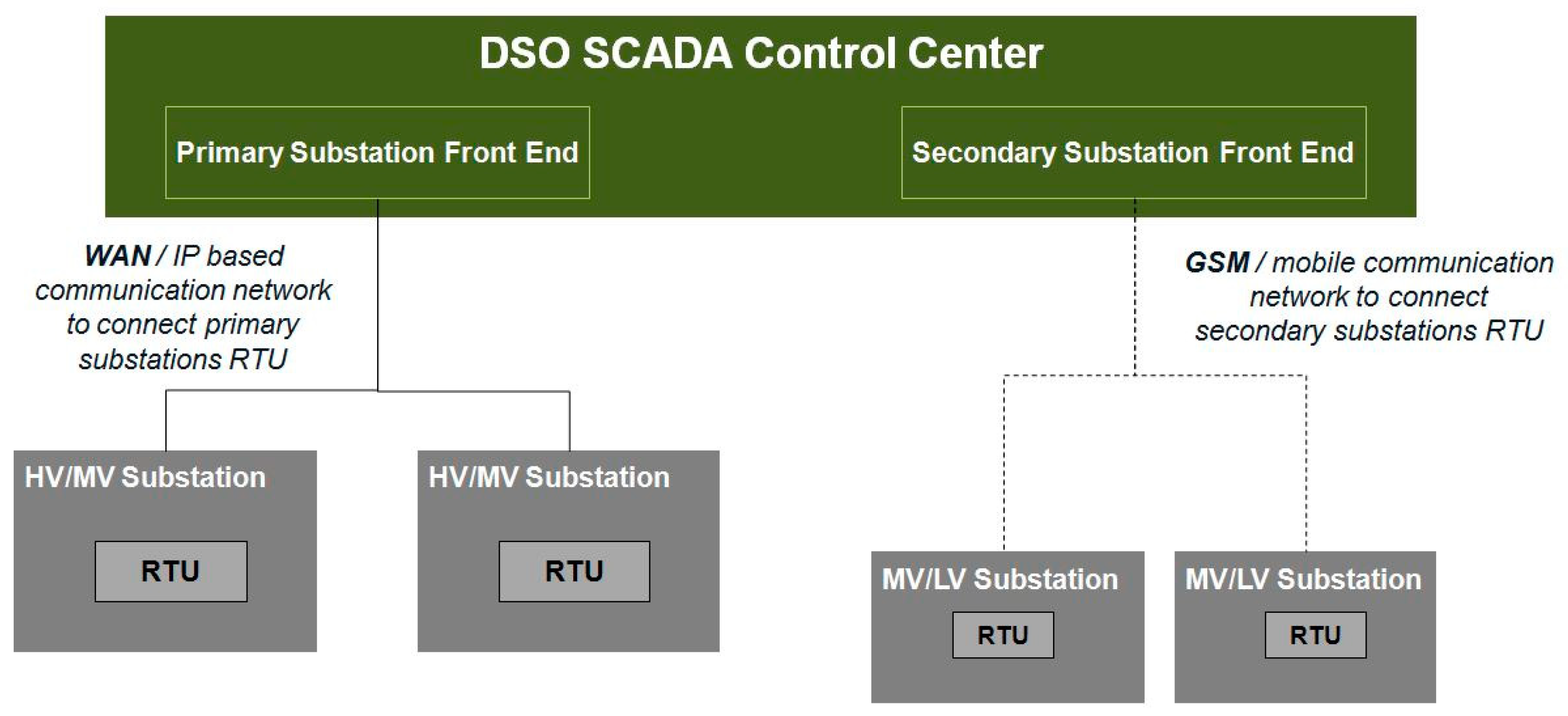
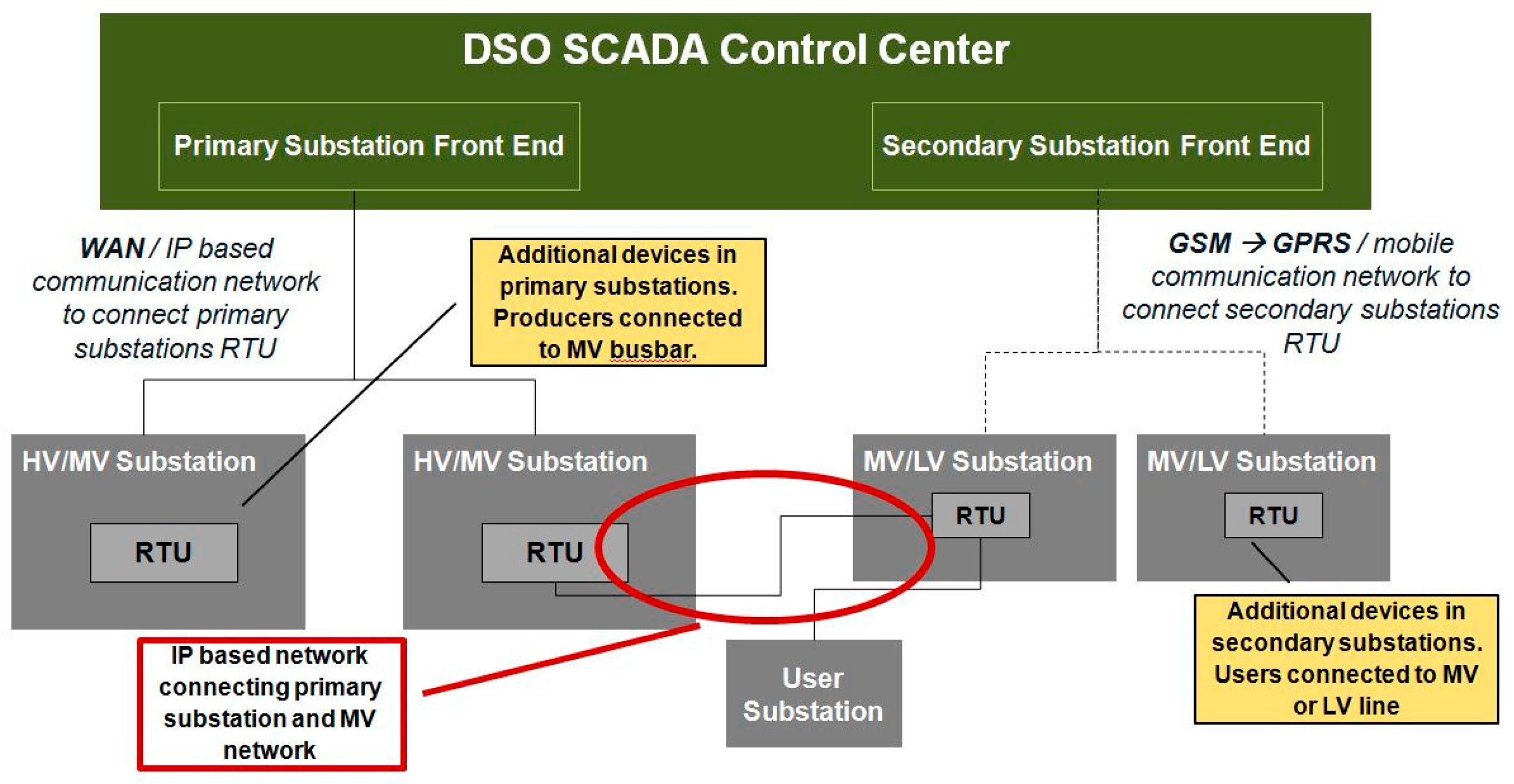
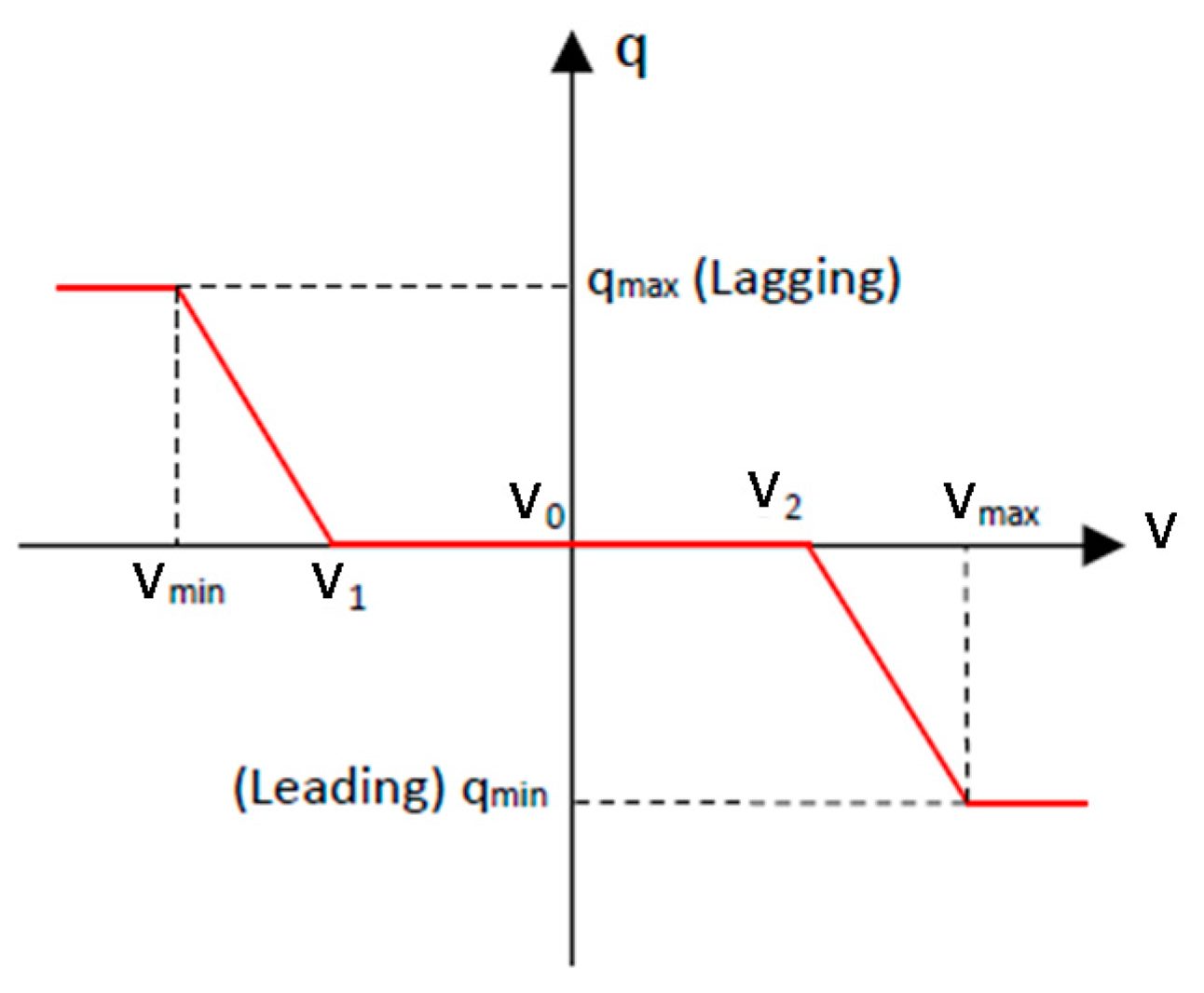
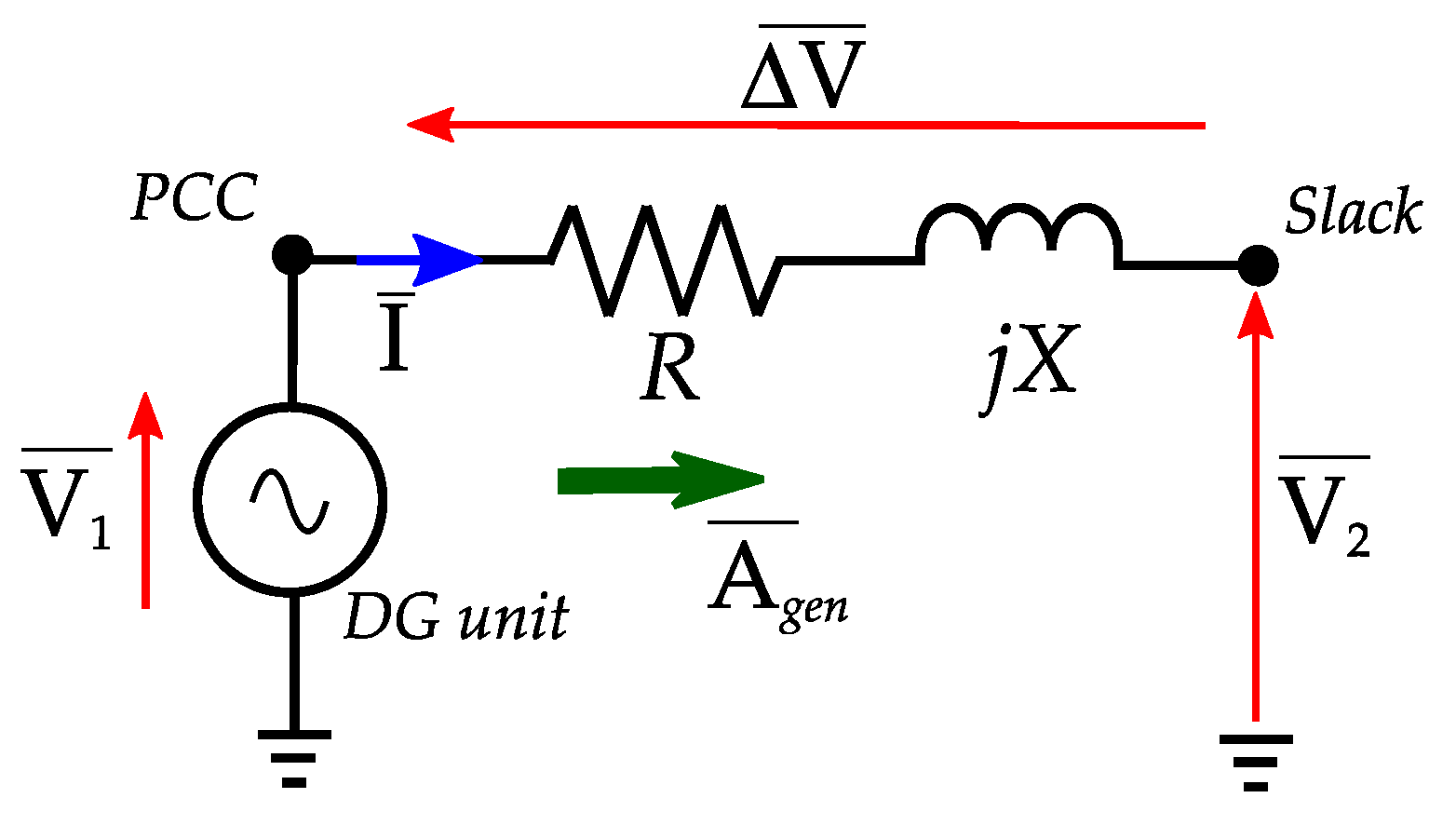
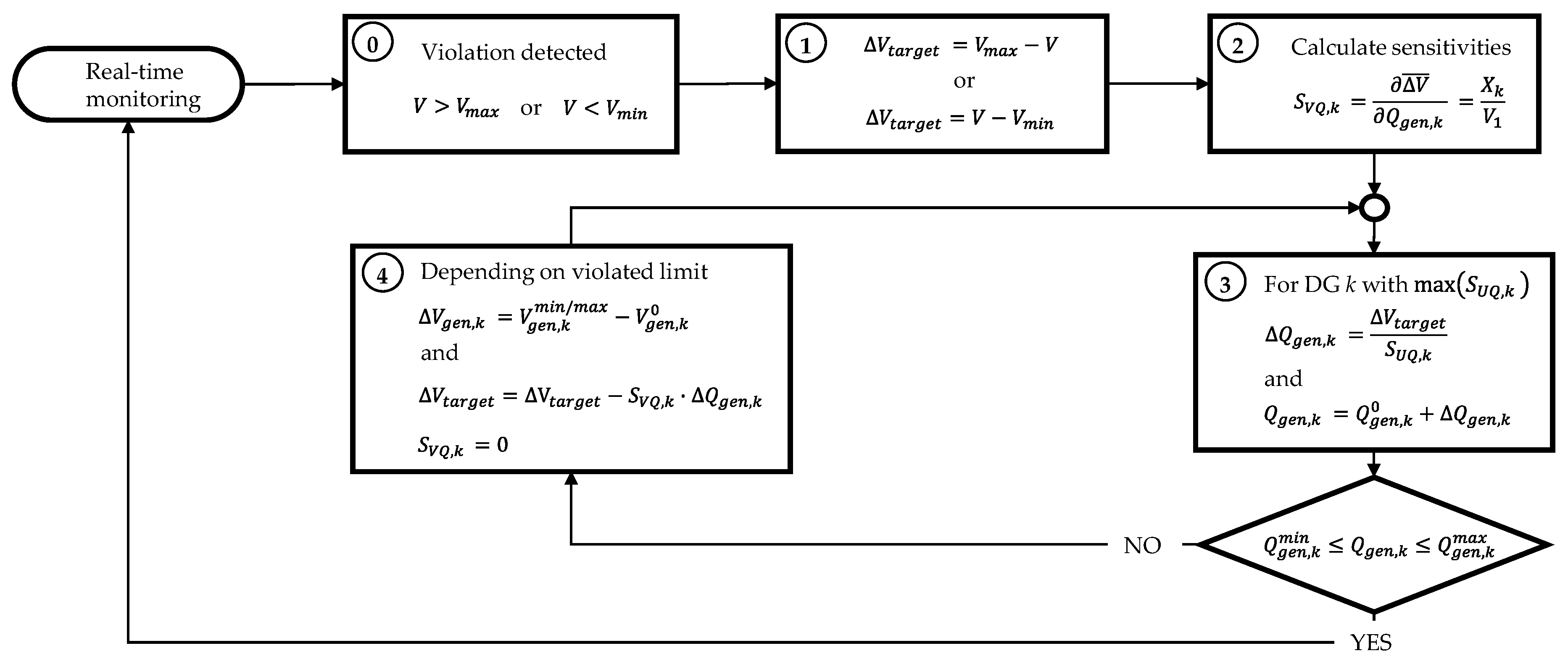
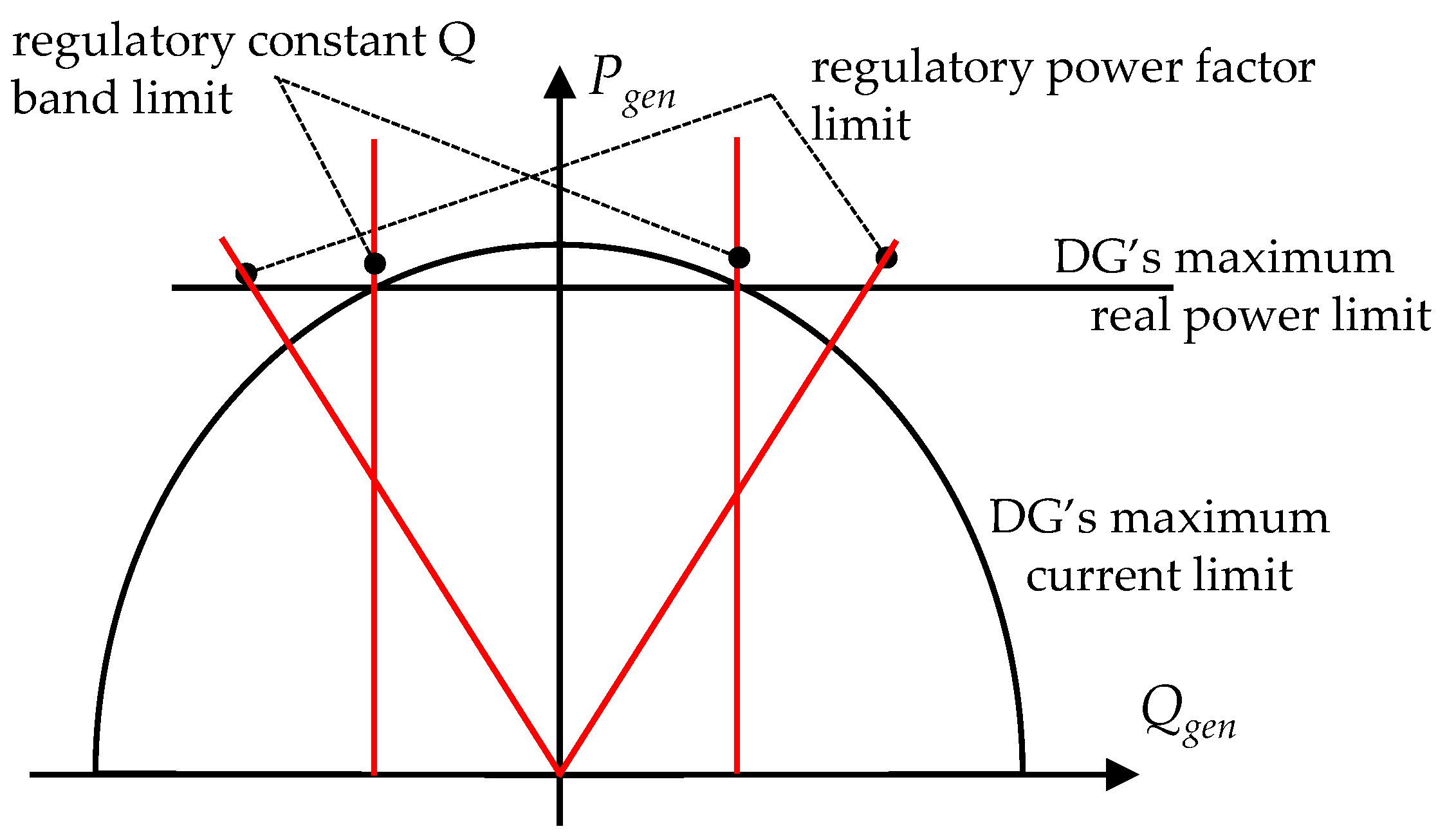
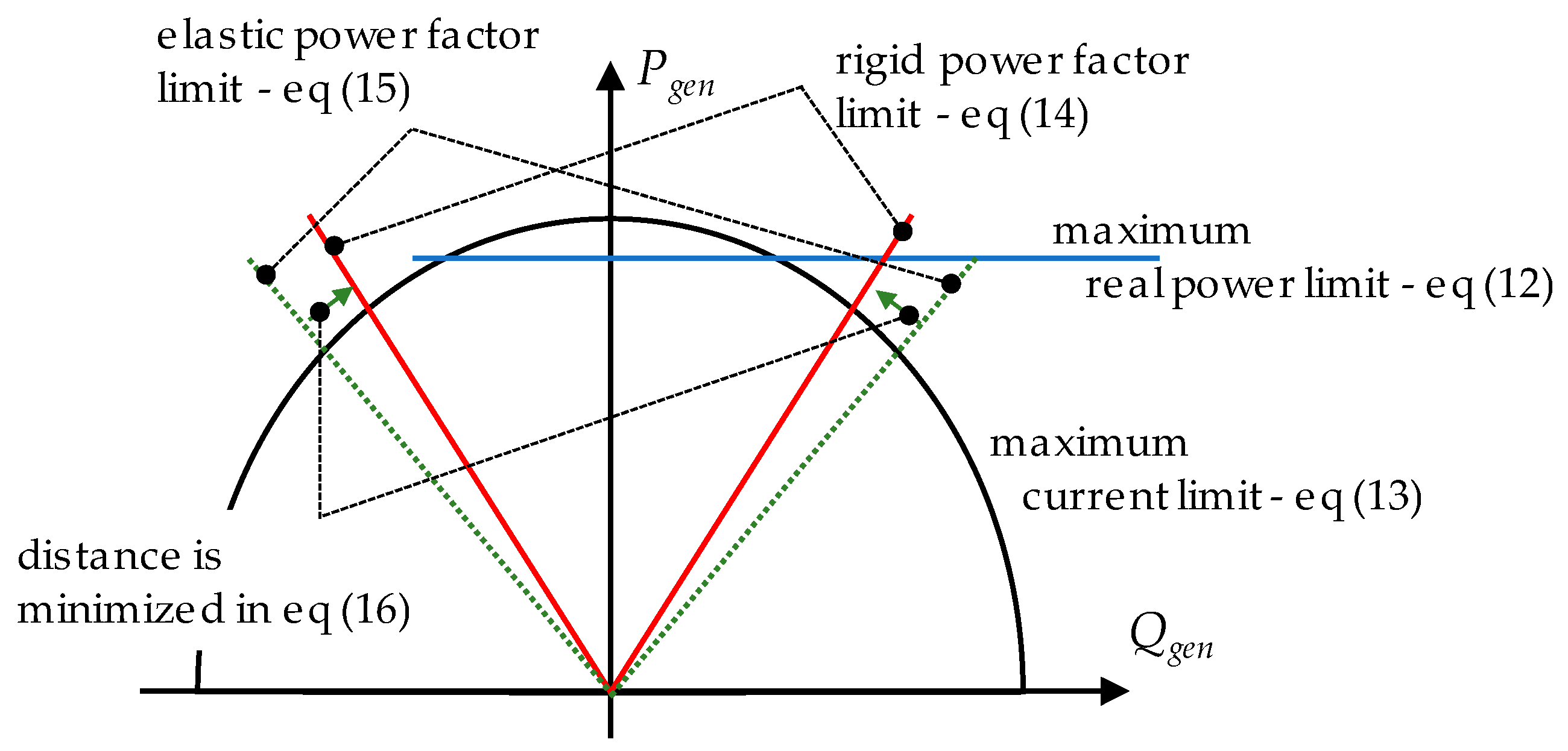


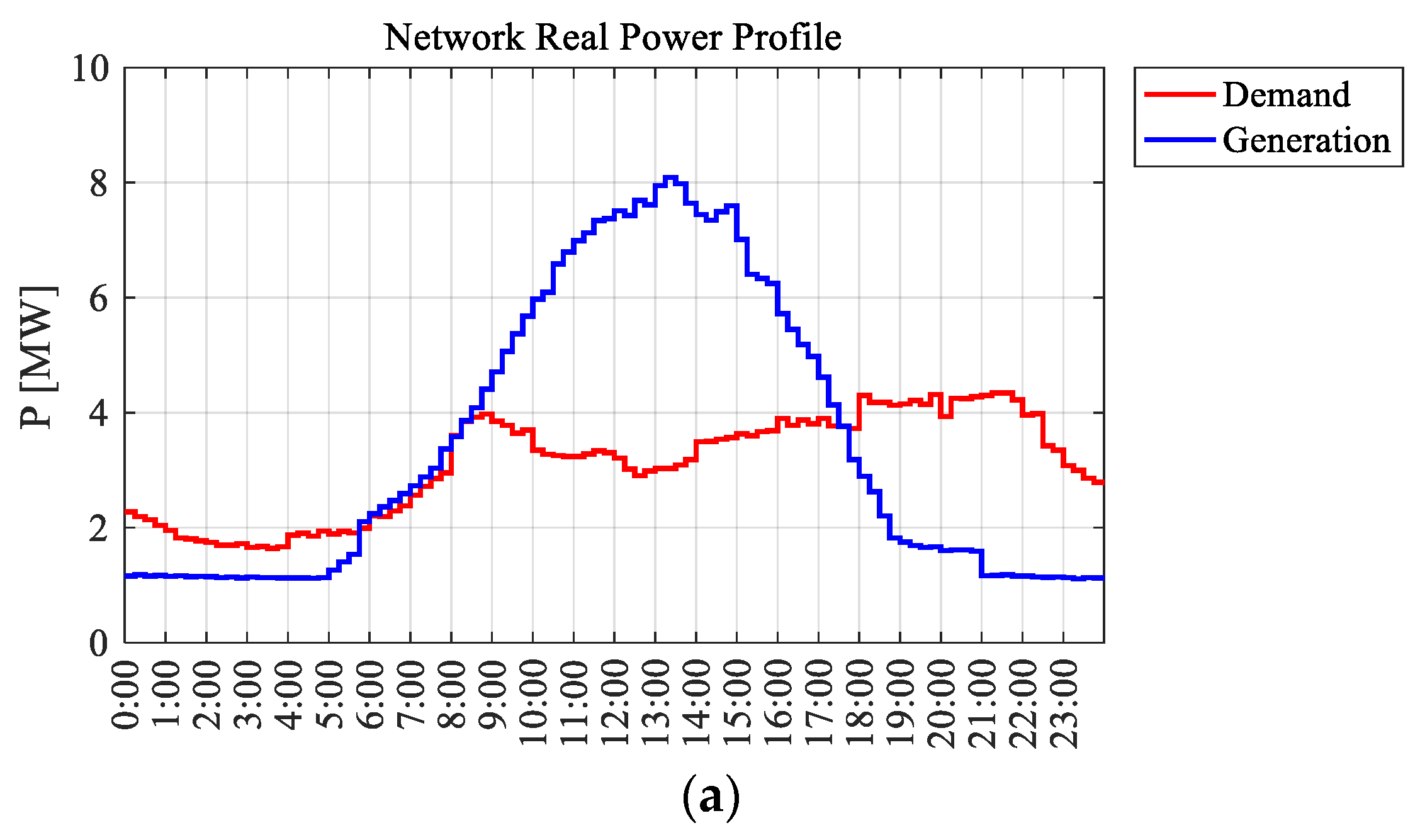

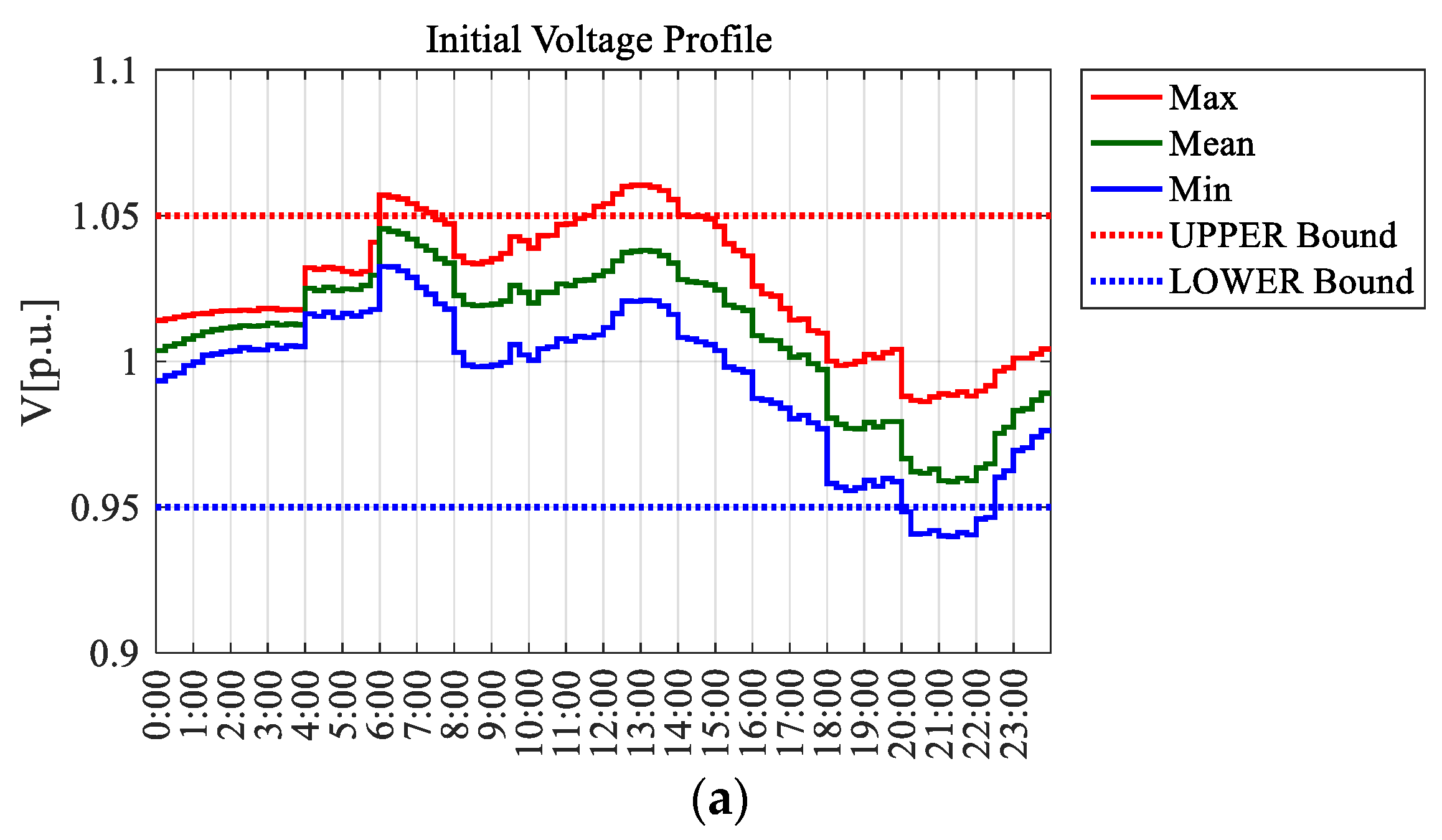
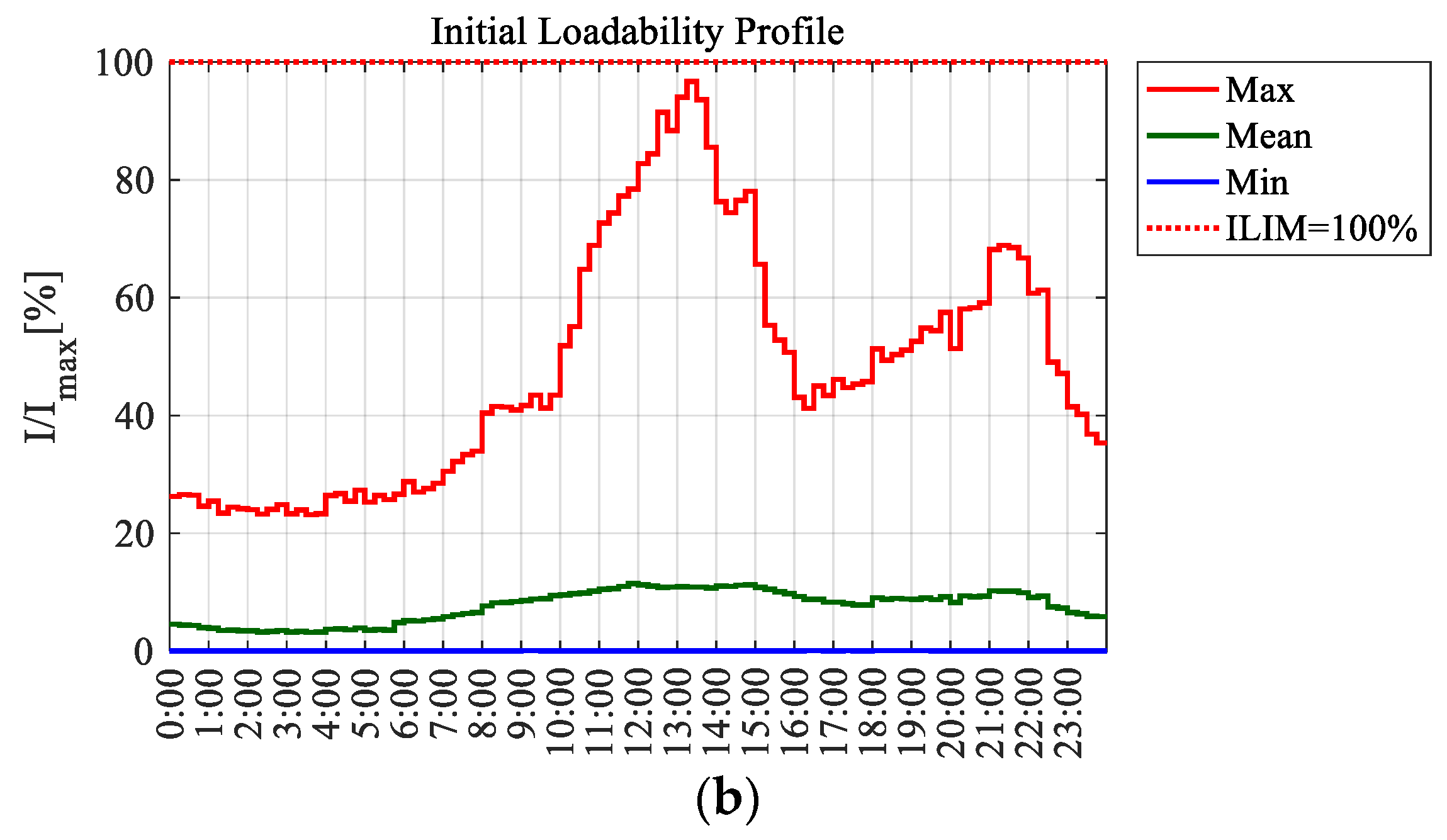
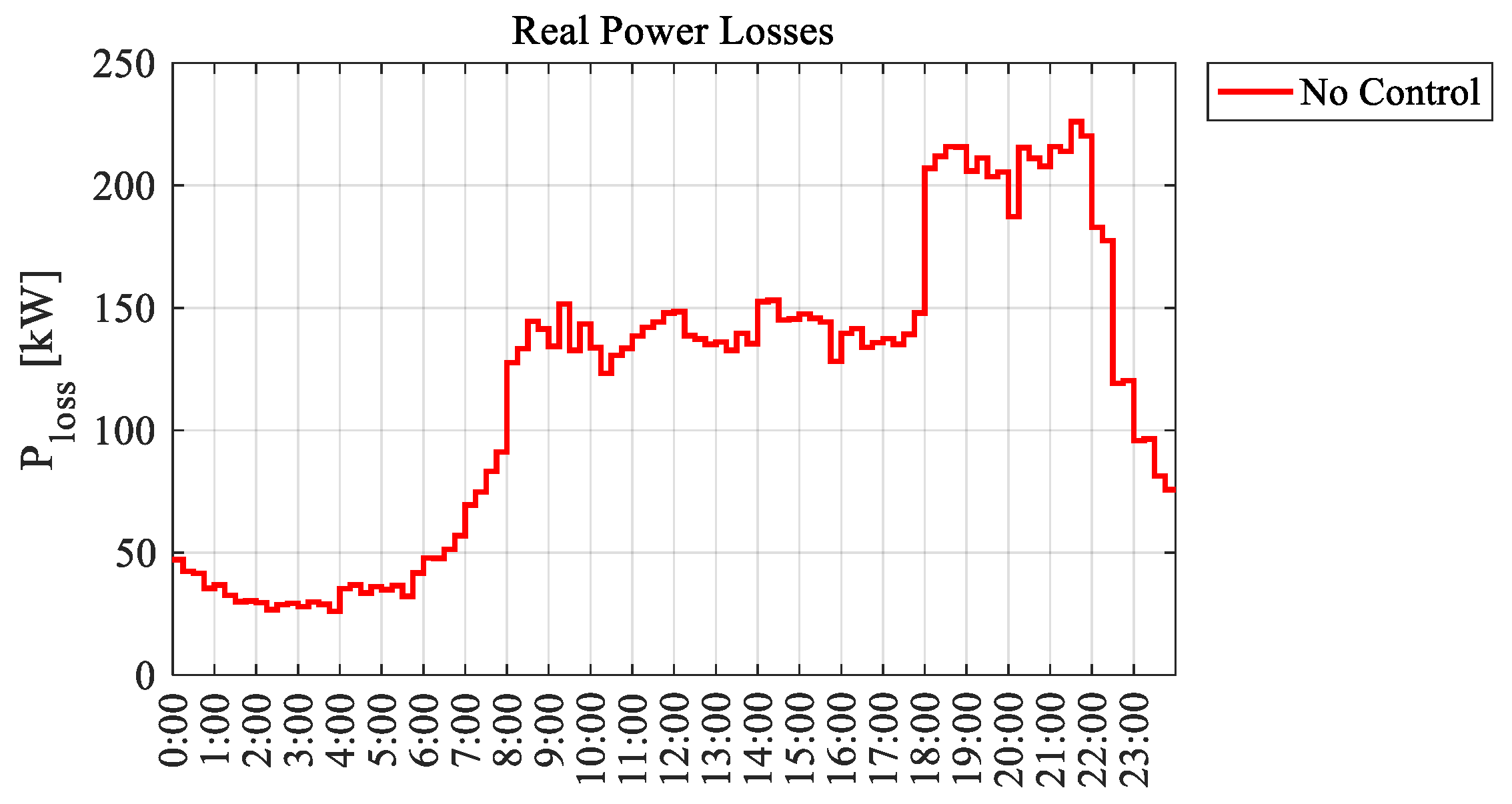

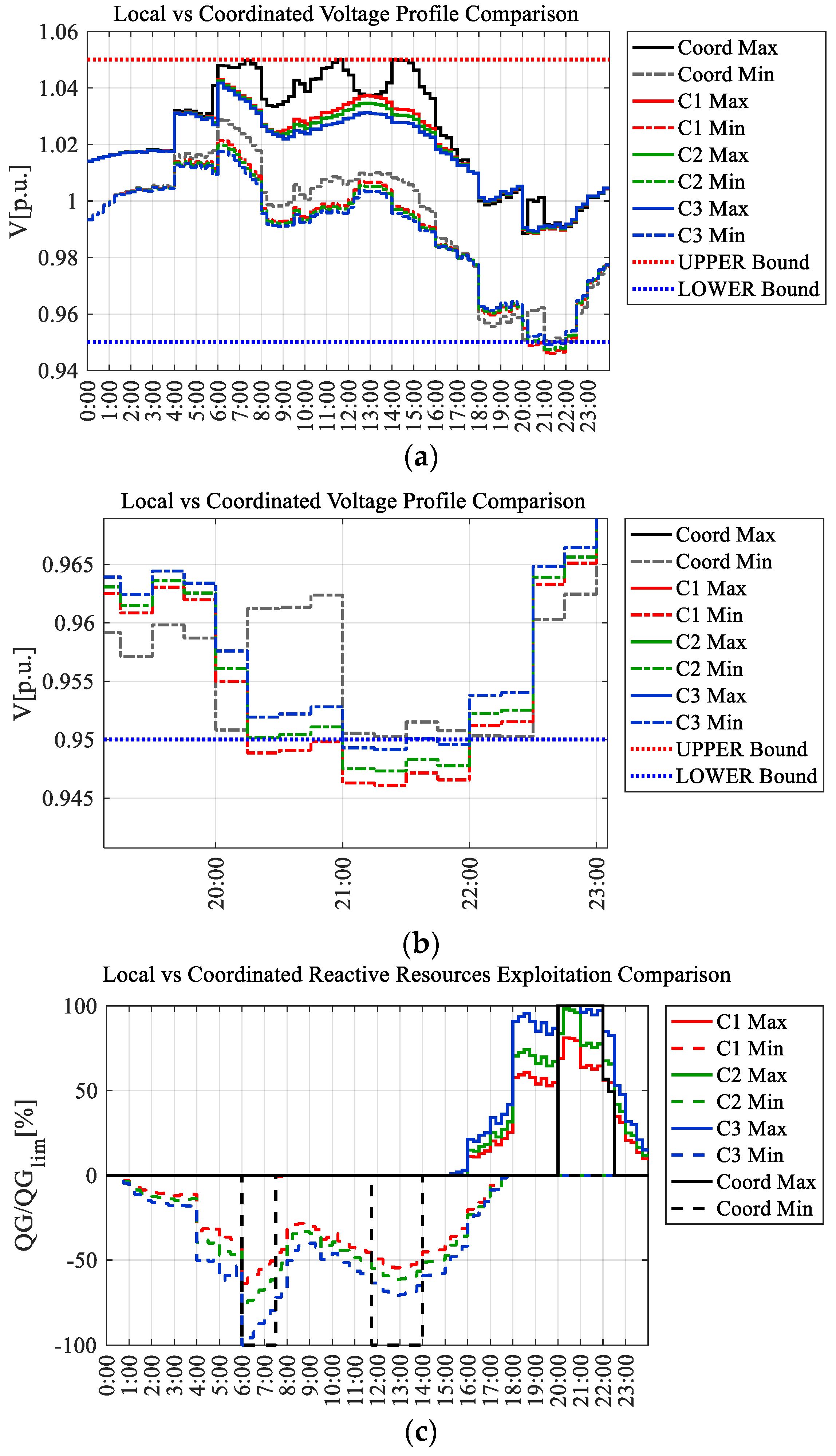

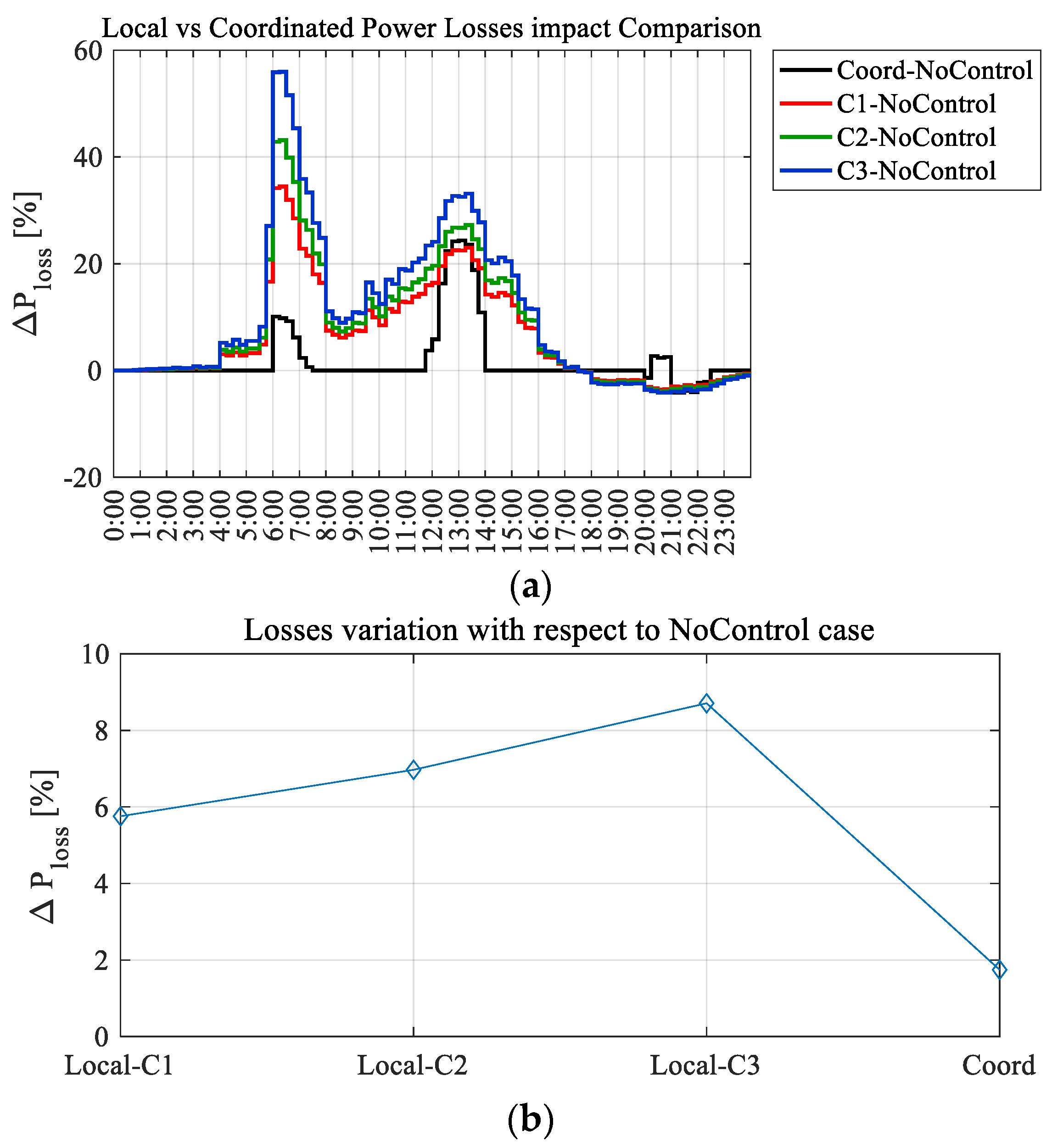

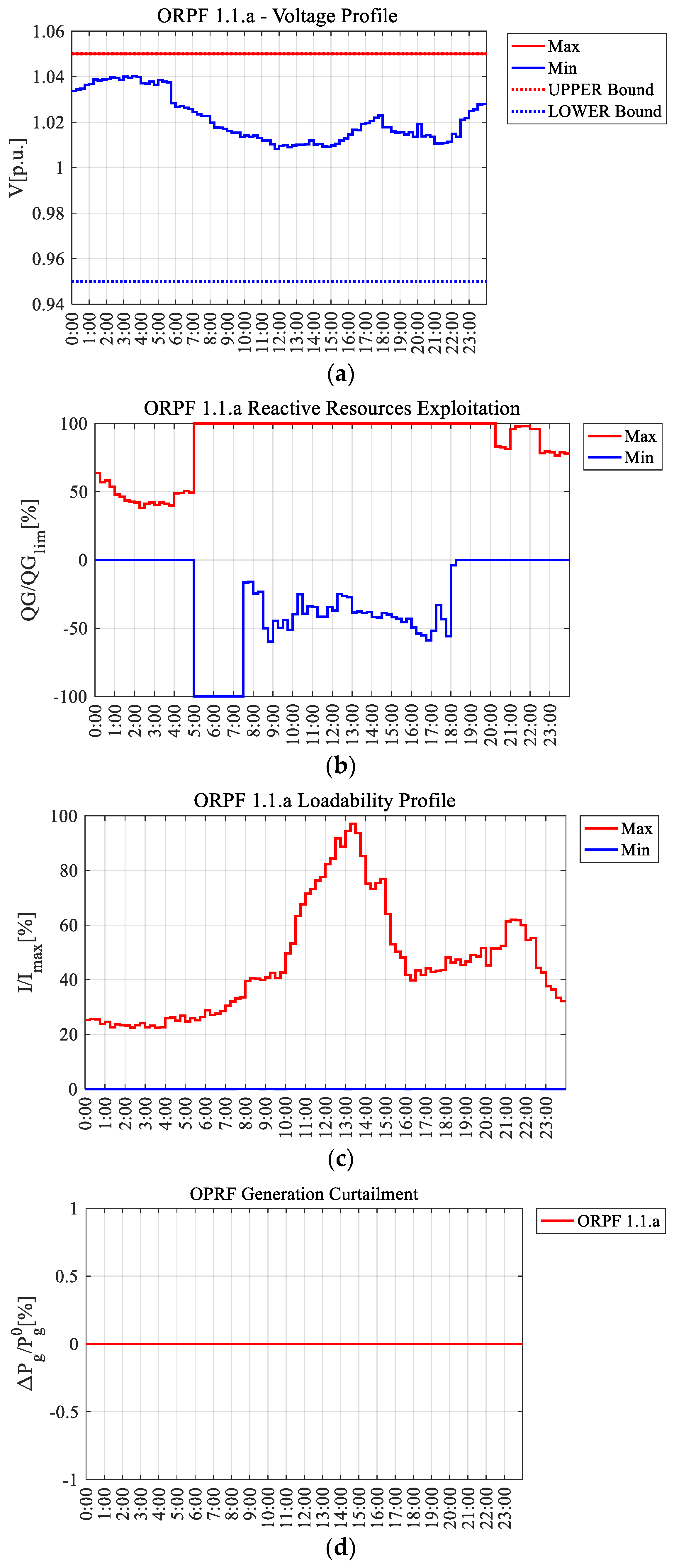
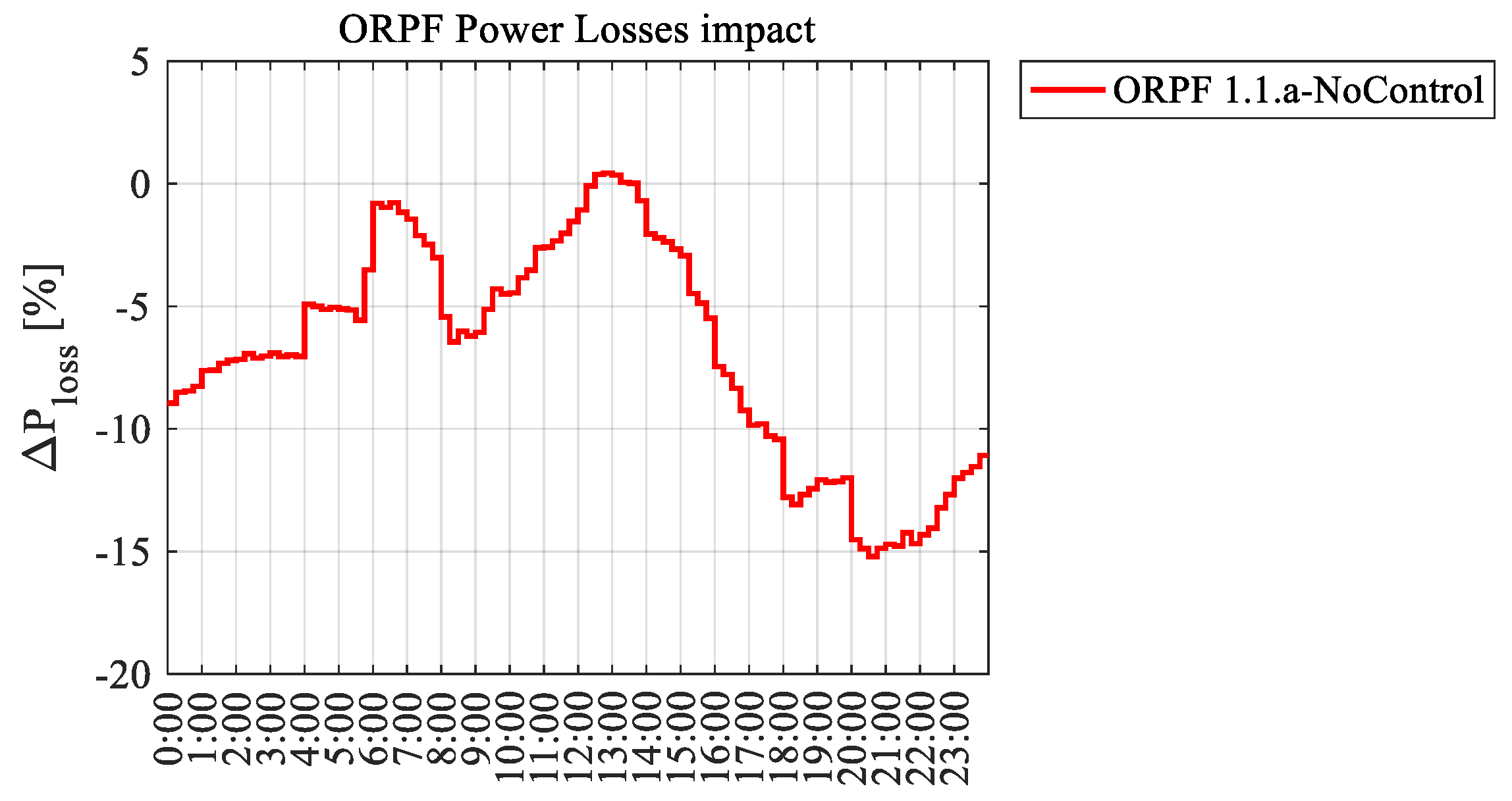


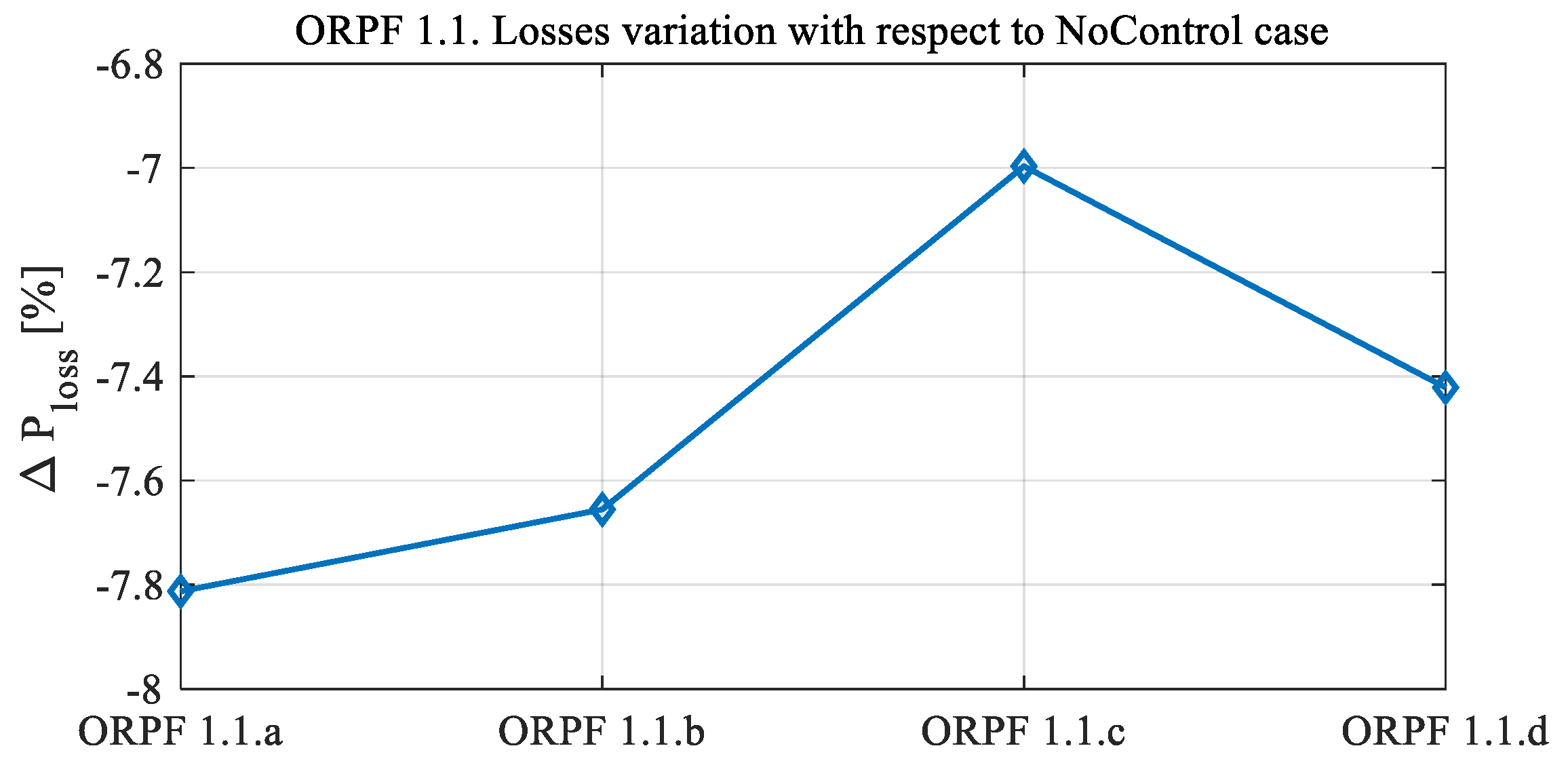
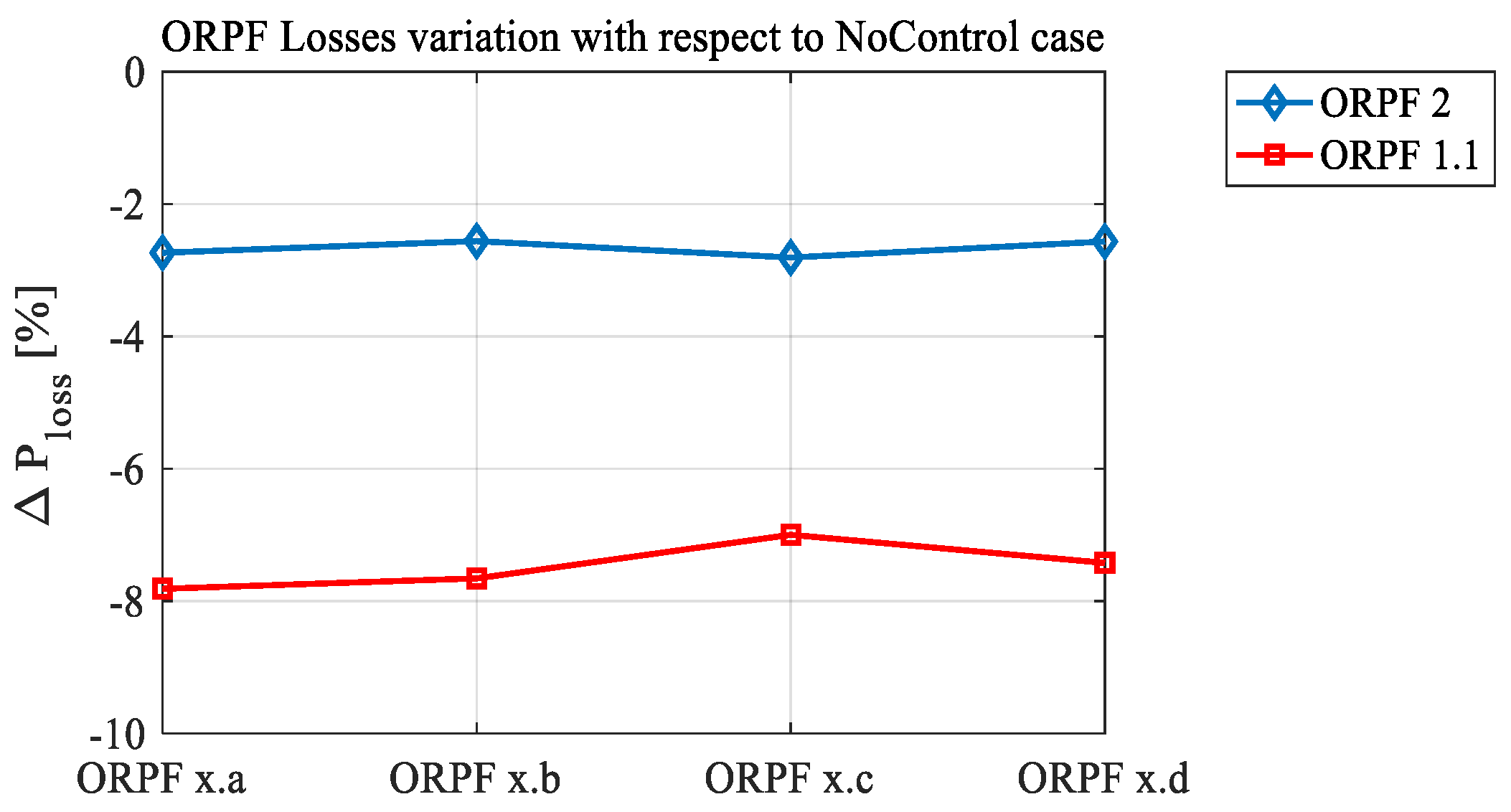


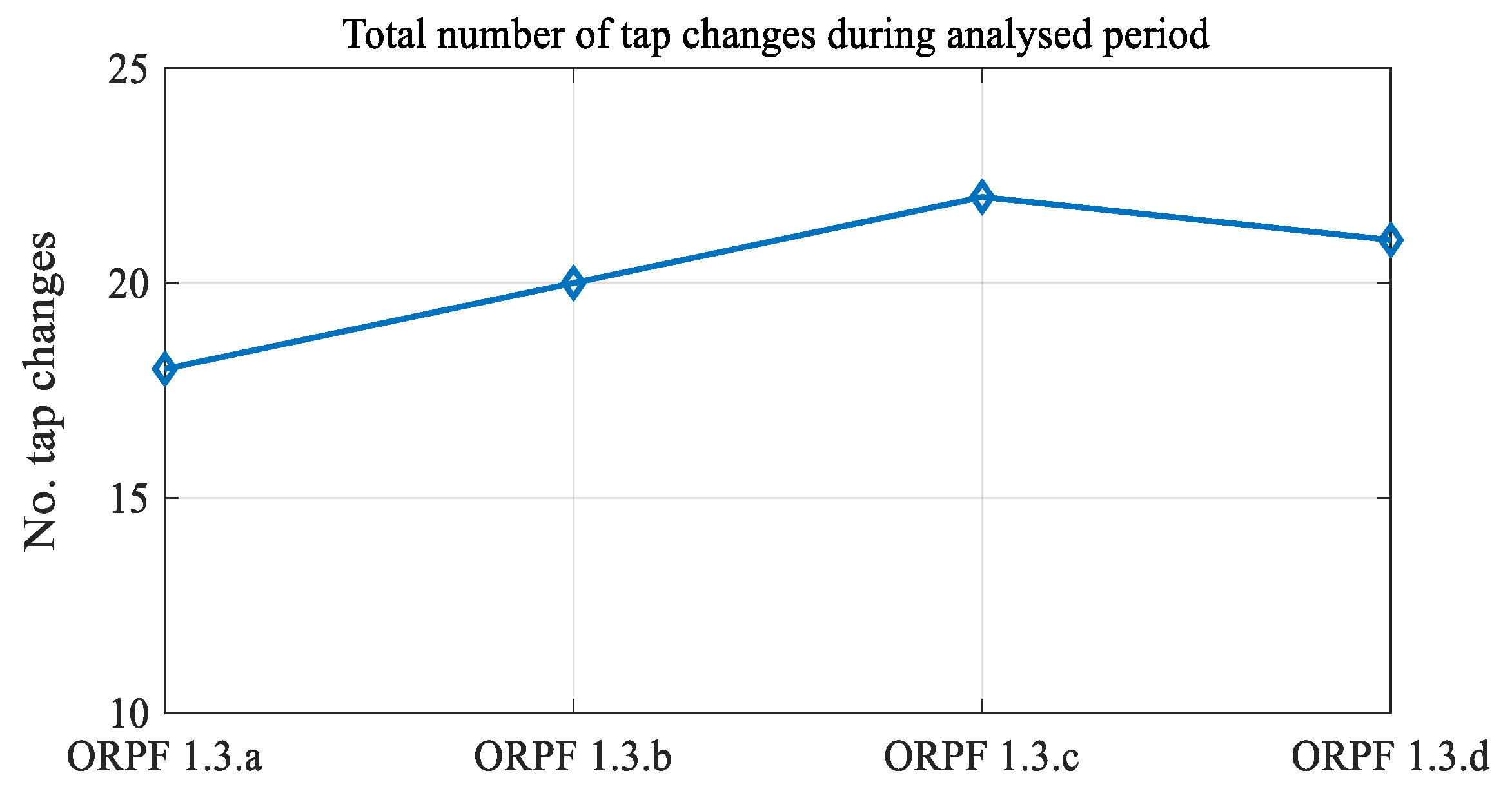
© 2020 by the authors. Licensee MDPI, Basel, Switzerland. This article is an open access article distributed under the terms and conditions of the Creative Commons Attribution (CC BY) license (http://creativecommons.org/licenses/by/4.0/).
Share and Cite
Ilea, V.; Bovo, C.; Falabretti, D.; Merlo, M.; Arrigoni, C.; Bonera, R.; Rodolfi, M. Voltage Control Methodologies in Active Distribution Networks. Energies 2020, 13, 3293. https://doi.org/10.3390/en13123293
Ilea V, Bovo C, Falabretti D, Merlo M, Arrigoni C, Bonera R, Rodolfi M. Voltage Control Methodologies in Active Distribution Networks. Energies. 2020; 13(12):3293. https://doi.org/10.3390/en13123293
Chicago/Turabian StyleIlea, Valentin, Cristian Bovo, Davide Falabretti, Marco Merlo, Carlo Arrigoni, Roberto Bonera, and Marco Rodolfi. 2020. "Voltage Control Methodologies in Active Distribution Networks" Energies 13, no. 12: 3293. https://doi.org/10.3390/en13123293
APA StyleIlea, V., Bovo, C., Falabretti, D., Merlo, M., Arrigoni, C., Bonera, R., & Rodolfi, M. (2020). Voltage Control Methodologies in Active Distribution Networks. Energies, 13(12), 3293. https://doi.org/10.3390/en13123293







